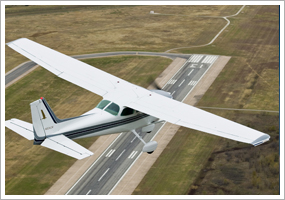| The following stories from the March 12, 2010, edition of AOPA ePilot were provided to AOPA members who expressed an interest in the particular subject areas. Any AOPA member can receive information tailored to their areas of interest by updating their preferences online. - My ePilot -- Helicopter Interest -EADS North America delivers 100th helicopter to ArmyDelivery of the 100th UH-72A Lakota helicopter occurred on March 4 at American Eurocopter’s production facility in Columbus, Miss., where the twin-engine helicopter is produced. The facility, operated by EADS North America’s American Eurocopter business unit, has an average production rate of three to four helicopters per month. The 220,000-square-foot facility, located adjacent to the Golden Triangle Regional Airport, is capable of producing up to five aircraft a month. Read more >> Aspen Avionics gains STC for Bell 206 and 407 helicoptersAspen Avionics Inc. has announced the approval of a supplemental type certificate (STC) for installation of the Aspen EFD1000H into the Bell 206 and Bell 407 model helicopters. This STC was developed in partnership with Keystone Helicopters. According to the company, the EFD1000H is the latest addition to the Evolution Flight Display System. Read more >>
TRAINING TIPs‘Change of plans’
What traffic pattern entry will you be instructed to fly? It jars your ear slightly to hear the tower controller instruct you to “enter a right base leg for Runway 29.” But as you visualize your position, that makes sense. On your present southwesterly heading, you’re practically established on that leg already. Although right traffic is infrequent at non-towered airports like your home base, you know that it is readily available with a control tower directing operations (see the Nov. 5, 2004, Training Tip).
All is well. But when the tower calls your number again, some new instructions have you playing catch-up. “Change of plans,” says the controller. “Enter the right downwind for Runway 36. Traffic will be departing on Runway 29, a Boeing 737.”
Calmly you consider this change and realize that only a minor adjustment is required. Good thing your ground study of potential cross-country destinations has included lots of practice visualizing traffic patterns and entries. Otherwise, this could be a setup for problems. Landing mishaps involving new pilots faced with unexpected instructions are not uncommon when the pilot became unnerved or could not restabilize the approach. That’s unfortunate, because changes of plans are often the name of the game. The AOPA Air Safety Foundation’s Safety Advisor, Operations at Towered Airports , gives examples:
“Be flexible. Controllers at busy airports use a variety of techniques to keep traffic flowing smoothly. You may be asked to:
Remember that a different active runway means different headwind or crosswind components on final approach. And don’t forget about surface conditions. One pilot who decided to switch runways during practice found icy hazards waiting, as recounted in this report on a minor incident.
Bottom line: Stay alert! A change of plans is always possible. TRAINING PRODUCTSNew pilot store offers 12-month guaranteeRed Prop Pilot Store, a new online aviation product retailer, is offering a special guarantee. Instead of a standard manufacturer warranty, Red Prop Pilot Store will act as a middleman and guarantee any product it sells for 12 months. According to the store, it will fix or replace anything that’s a problem immediately. The store sells headsets, chart accessories, flight bags, and more.
Note: Products listed have not been evaluated by ePilot editors unless otherwise noted. AOPA assumes no responsibility for products or services listed or for claims or actions by manufacturers or vendors. FINAL EXAMQuestion: I am 25 years old and have a combination student pilot certificate/third class medical that was issued in June 2007. My flight instructor told me that the student pilot certificate has expired even though my third class medical is good until June 2012. Is he correct? If so, can I get a new student pilot certificate without having to get a new medical as well?
Answer: Yes, your flight instructor is correct. At the time your student pilot certificate was issued, its validity period was 24 months. The regulations changed, though, on Oct. 20, 2009. A student pilot certificate for an individual under the age of 40 at the time of his or her medical exam is now good for 60 months; for those over the age of 40 it is valid for 24 months. You can get a new student pilot certificate from a designated pilot examiner (DPE) or your local flight standards district office (FSDO). It is not necessary to get a new medical because your current one is still valid. It also contains your solo endorsements, so be sure to hold on to it. See AOPA’s Guide to Leaning to Fly for more information.
Got a question for our technical services staff? E-mail [email protected] or call the Pilot Information Center, 800/872-2672. Don’t forget the online archive of “Final Exam” questions and answers, searchable by keyword or topic. |
 You’re inbound to a busy tower-controlled airport with two long runways. Surface winds are out of the northwest, so it’s logical to expect that you will be landing on Runway 29. The ATIS broadcast confirms that this runway is in use.
You’re inbound to a busy tower-controlled airport with two long runways. Surface winds are out of the northwest, so it’s logical to expect that you will be landing on Runway 29. The ATIS broadcast confirms that this runway is in use.

